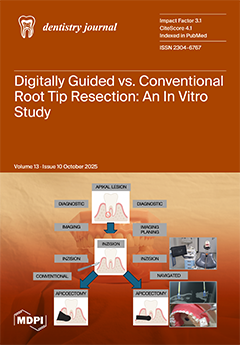Background: Gingival recession (GR) is defined as the exposure of the root surface due to the gingival margin shifting apically from the cemento-enamel junction. Current effective management of defects related to GR relies on root coverage periodontal plastic surgery (RCPPS), using the Modified Coronally Advanced Flap (mCAF) with an envelope design. Recent literature also reported the association of different biomaterials to the mCAF procedure. In light of these considerations, a systematic review (SR) was conducted to determine and compare the efficacy of all mCAF adjunctive techniques for the treatment of multiple adjacent GR-type (MAGR) defects.
Methods: An electronic search was conducted in 2025 on studies published between 2013 and 2025, using PubMed, Scopus, Web of Science, and Cinahl Complete, to address the focused question: “which is the efficacy of different mCAF adjunctive techniques for the treatment of multiple adjacent GR-type defects, in terms of root coverage (RC), esthetic outcomes, and keratinized tissue (KT) augmentation?”. Randomized controlled trials with a minimum follow-up of 6 months with ≥ 5 patients treated for coverage of MAGR were included. Risk of bias was assessed with RoB 2 Tool. A meta-analysis was performed using RevMan5.4 software and the level of evidence of included studies was analyzed with GRADEPro GDT.
Results: A total of 17 studies were included in the SR, 9 of which evaluating mCAF + sCTG (subepithelial connective tissue graft) vs. mCAF adjunctive techniques [Collagen Matrix (CM), xenogeneic acellular dermal matrix (XADM), Platelet-Rich Fibrin (PRF), Enamel Matrix Derivatives (EMD), sCTG harvested double blade scalpel] were then included in the meta-analysis. The primary outcomes of complete root coverage (CRC) and keratinized tissue width variation (ΔKTW) were statistically significant ([CRC: Odds Ratio (OR) 1.70; 95% CI (confidence interval) 1.18, 2.44;
p = 0.004]; [ΔKTW: SMD (standardized mean difference) 0.37; 95% CI 0.11, 0.63;
p = 0.005]) in favor of mCAF + CTG. Meanwhile, no statistically significant difference was observed in terms of RES. The certainty assessment highlighted relevant results: despite the lack of evidence in the long-term, a high level of evidence showed that sCTG was more effective than XADM in terms of CRC (
p = 0.002) and ΔKTW (
p = 0.0001). A low level of evidence revealed that sCTG achieved a greater ΔKTW compared to CM (
p = 0.0006). Although no significant differences were observed, a low level of evidence suggested that mCAF + EMD and mCAF + sCTG (DBS) may provide good results. To date, only one RCT showed long-term stable results of CTG in terms of RC.
Conclusions: The association of sCTG to mCAF demonstrated better results in terms of RC and KTW augmentation in short- and medium-term follow-ups. Long-term studies are needed to confirm the efficacy of the other mCAF adjunctive techniques, considering limitations due to heterogeneity in follow-ups, distribution of techniques analyzed, and different study designs. Registration in PROSPERO (International prospective register of systematic reviews) was performed with ID CRD420251085823.
Full article






